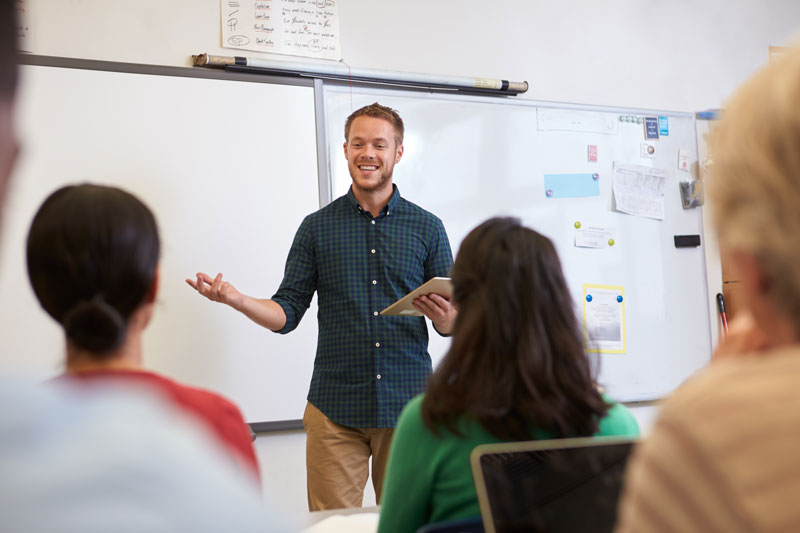In today’s busy education world, it’s easy to get caught up in the activities of day-to-day teaching and leave no time for self-reflection. But self-reflection is an important part of what can make you a good teacher and can be hugely valuable. It gives you the time to think deeply about your teaching: about what you do in the classroom, why you do it and why it works, enabling you to identify any changes and improvements you could make.
Why should I self-reflect?
Teaching is one of the most meaningful careers. Teachers are educating future doctors, scientists, artists and professionals. Self-reflection can help you recognise the progress you made in a lesson, whilst simultaneously allowing you to consider improvements that you could make.
‘Follow effective action with quiet reflection, from the quiet reflection will come even more effective action’ – Peter F. Drucker.
We learn from experiences and mistakes. But, unless we question ourselves about what our experiences mean and think actively about them, research has shown that we won’t make any changes. Self-reflection enables you to move from just experiencing into understanding.
Self-reflection:
- Encourages a level of self-awareness and consciousness about practice
- Enables you to identify areas for improvement as well as areas where you are strong
- Allows you to recognise what works and what doesn’t with students
- Enables you to think deeply about students’ reactions to your teaching.
Self-reflection is something that we all do both naturally, at an almost subconscious level, and purposefully. Normally, when we think about our actions or practice, what we see is not actually a true reflection of reality, but one that is slightly skewed. Some people will self-reflect and think, ‘I’m pretty much perfect’ and others will think ‘I’m rubbish’. Neither of these thoughts are likely to be entirely true, although elements may be.
When is a good time to self-reflect on teaching?
It’s difficult to self-reflect on your teaching as it’s happening, because there will be a hundred other things going on in the classroom that need your immediate attention. So, logic dictates that waiting until later to reflect is more beneficial. Let’s consider the four modes of thinking:
1. Technological – Technological thinking uses knowledge gained from an external source and relies on practice that has already been proven as effective, e.g. a teacher adopting general policies that are part of their school’s culture.
2. Situational – Situational thinking focuses on information that is embedded within a specific context and moment of time, e.g. a teacher responding to student behaviour as it occurs. Situational thinking is quick and responsive: action is taken immediately.
3. Deliberate – Deliberate thinking occurs when the teacher seeks more information than that which the immediate situation provides, e.g. by looking back on the lesson after it has ended, asking students for their opinions, discussing the lesson with colleagues. Teachers who want to better understand why the lesson went the way it did would utilise deliberate thinking.
4. Dialectic – Like deliberate thinking, dialectic thinking aims to gain greater understanding of a situation, but dialectic thinking has the goal of generating solutions and making improvements.
Technological and situational thinking are both reactionary, whereas deliberate and dialectic thinking are self-reflective. They can only take place after the lesson has ended, when you are feeling open-minded and ready to consider why the lesson went the way it did and can think carefully about how to make changes and improvements.
When we can objectively reflect, self-reflection becomes a hugely powerful way of improving practice. We must see ourselves as we appear to others, and the only way to do this is to use video. Not many people like what they see on video out of a sense of embarrassment. But once the cringing feeling passes, there’s no more powerful way to identify strengths and weaknesses, identify areas for improvement, set measurable targets, track improvements, and see through fresh eyes how students respond to you.
How do I self-reflect?
Ask yourself questions that challenge your assumptions: How effectively am I performing? What are my strengths and areas for improvement? How can I improve these areas? What improvements have I made in this lesson and what do I need to do now? How will I know I have made improvements?
As mentioned, video can be a great way to aid reflection. Since you can only self-reflect effectively once you have left the lesson environment, it can be difficult to remember exactly how everything had gone on in the classroom. Recording your lessons can help provide you with an objective perspective; helping you to notice things you may not have otherwise remembered. Videos can also become resources that you can re-visit and watch again to gain deeper insight into the lesson.
Developing a habit of self-reflecting will lead to a natural process of evaluation. You will become accustomed to asking yourself these questions, and because self-reflection is a cyclical process, once you start to implement changes in your lessons, the reflective and evaluative cycle will begin again.
Self-reflection is not about focusing solely on the negative; it also enables you to think about what you do well. It gives you a structured method for also considering what is positive about your teaching.
IRIS Connect allows you to record video and audio of your classroom teachings for the most effective self-reflection experience. To find out more about how you can use video for self-reflection in teaching and get a FREE demo, contact us.

